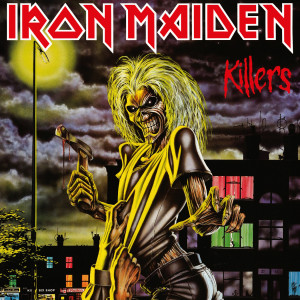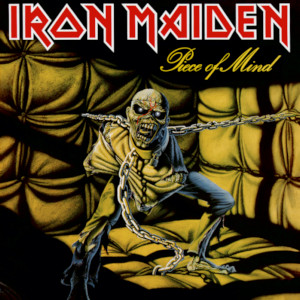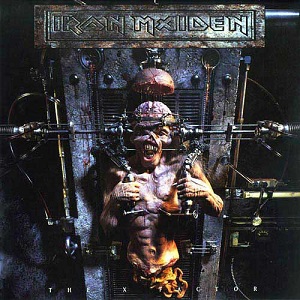Picture This: The Rise and Fall of Iron Maiden
in Sixteen Album Covers
A Personal View
Well, maybe not. Probably not, really, but it's interesting how you can trace the change in the band's fortunes through the various album covers over the course of their career.
 1981 – Iron Maiden
1981 – Iron Maiden
“Hello there, I'm Eddie, nice to meet you. Now die!”
Look at the face of Eddie on the cover of the debut. He's a punk, isn't he? Without the capital P. A loser, a ne'er-do-well, a lout you wouldn't want to run into down a dark alley. He's sporting crazy spiky yet long hair which would later be robbed by a band called Sigue Sigue Sputnik for their signature look; it doesn't have the appearance of even knowing what a comb is, much less having used one. Like many Iron Maiden covers, it's drawn taking place at night. The moon is high and pale in a gloomy sky, and Eddie is standing – perhaps we might say lurking – under a streetlight, obviously up to no good. He's angry, he's aggressive, he's out for your blood. Like Horslips once wrote, “if you see me you had better run, run run!” And you would. This guy isn't going to ask you for a cigarette, unless it's made out of your windpipe which he'll happily extract with none of the precision of a surgeon, or if you happen to know the score of the big match? He's a troublemaker, a skinhead with lots of hair, a headbanger.
And it's your head he wants to bang, preferably against that wall behind him.
So our first introduction to Eddie – and by extension, Iron Maiden – is hardly a welcoming, pleasant one. Perhaps Eddie is saying “come and have a listen if you're hard enough”, who knows? But it's an aggressive, threatening cover that simmers with barely-restrained violence and possible murder, which will take its natural (!) course on the cover of the next album. One thing is for sure: Eddie is in control here, and if you want to survive you had better pay him big respect! This is a band who say “We're here; don't get in our way or we will f
uck you up, and if you can't handle our music go listen to Barry Manilow or the Black and White Minstrel Show!” Or something. The point is, it's a statement of power, intent and aggression. Iron Maiden have arrived. Deal with it.
 1980 – Killers
1980 – Killers
And if you can't deal with it, here's what will happen. Eddie has now evolved (devolved?) from the street punk threatening you on the corner to a full-blown maniac, his hair more carefully arranged but that snarl still on his face, a face that enjoys slaughter, pain and terror, and in his hand this time is an axe. Careful with it, Eugene! I'm not Eugene, I'm Eddie, and I'll put it where I like. And where I like is the centre of your head!
If any album cover depicted naked aggression, many do but this one certainly does, and it ties in well with the album title, leaving you in no doubt as to what to expect on the album. In terms of power, Eddie has grown from the dodgy punk throwing shapes at you from under a streetlamp to a dangerous, homicidal killer who's ready to satisfy his awful urges. He's taking no sh
it from anyone, and as the lyric in the title track growls, “he laughs as he's watching you bleed.” But you laugh too, because this music is so good. On the last album Maiden announced their arrival, on this one they declare their intention of not just making up the numbers. But if world domination is on their minds, there's a small problem to be dealt with first, a kind of symbolic murder as one member is torn out of the band and left bleeding on the darkened roadway, and the remaining guys in the band slouch along the street, deaf to his cries, searching for a new leader.
 1982 – The Number of the Beast
1982 – The Number of the Beast
And they find it in Bruce Dickinson, the album cover reflecting their new power, as Satan makes Eddie dance to his tune, unaware that he is in fact the puppet controlled by a much larger Eddie. The symbolism couldn't be clearer, and Maiden are headed for big things. In terms of power, Eddie has now progressed beyond the lone axe-wielding killer and has the entire world at his feet, in a very real way, as Iron Maiden quickly became a household word on the back of this album, even terrifying the pop pickers on the local chart shows as their songs kicked their way up the “hit parade” (we'll just leave the “s” off the beginning, shall we?) and proved to all the world that metal was not only alive and kicking, it was taking over!
 1983 – Piece of Mind
1983 – Piece of Mind
Ah, poor Eddie! He appears to have been caught and put in the loony bin, sorry that's very insensitive isn't it? Nut hatch: there, that's better. But while Eddie may be a prisoner in a padded cell, he's angry as hell and I don't think anyone believes those chains are going to hold him for long, and when he gets free – watch out! This could be interpreted (which I'm sure is not the case but for the fun of it) as a response to those on the moral majority and the Bible belt, the do-gooders and self-appointed guardians of decency who completely mistook the previous album for a pagan, Satanic expression of youth (rather like the same people, or their forebears – maybe only three bears, I'm not sure – did with Black Sabbath a decade earlier) and had it banned and, probably, burned in a knee-jerk reaction.
The message here could be, you've managed to get some of public opinion and authority against us, but we're not going to lie down and die. Maybe it's you who should be in this asylum, and maybe the likes of us are the only sane ones. Or not. Though this cover may seem, on the surface, to be stripping Eddie of his power, I think we all know it's only a temporary situation and he is going to break out. Can't cage the Beast! The album also coincides with more chart success for Maiden, despite (or perhaps due to) the backlash from the Christian Right, proving once again the more those in authority don't want us to do it, the more we want to do it.
 1984 – Powerslave
1984 – Powerslave
And now Eddie achieves the ultimate. In every sense, he has become a god. He is worshipped by the faithful, frowning down on them from an image surely hundreds of feet high, a true Egyptian divinity. Interestingly, he no longer seems angry, just stern and unsmiling.
Powerslave is widely regarded as the high watermark of Iron Maiden's output, which makes the depiction of Eddie as a god all the more appropriate. The title of the tour to support it was the World Slavery Tour, which is apt in two ways: the world essentially was enslaved to Iron Maiden: they sold out every concert, every venue, leading to a tour that spanned over three hundred days. On the other hand, having to work almost right through the year must have made the boys feel as if they had become slaves themselves: slaves to the fans, slaves to the tour, slaves to promoters, slaves even to the music.
 1986 – Somewhere in Time
1986 – Somewhere in Time
Eddie has now moved into the future, an alienesque bounty hunter, and his traditional scowl is back, not that it ever left, except for the cover of The Number of the Beast. He's searching, and in itself this is a significant point, as the band – certainly Bruce anyway, and maybe Adrian – were searching for a new sound, a way to top their apex album, a way to follow up almost that which could and would never be followed up. Searching maybe for relevance in a changing world. Eddie is either naked, wearing very tight (and transparent) body armour or an exo-skeleton, but whichever it is, it's the first time we've seen his body this way, and while it's musclebound and sleek, I think it looks a little vulnerable too, his head slightly bowed as if he's not quite sure where his quarry is hiding, or why he is here.
In a lot of ways, I think this cover represents the uncertainty among the band of stepping beyond that classic album, the trepidation and perhaps even fear that they would not be able to measure up to its phenomenal success, and the concern about what the future held. Eddie looks pensive, thoughtful rather than his usual angry scowl or even maniacal grin. Like the band, he looks unsure.
 1988 – Seventh Son of a Seventh Son
1988 – Seventh Son of a Seventh Son
But two years later he's a godlike being again, as Maiden retrace their steps, perhaps in an effort to recapture the essence and atmosphere of
Powerslave, and go back, not forward, in time. Back to a time, in fact, which probably did not exist, to the age of legends and myths, the stories of the Arabian Nights and fairy tales and based around Orson Card's novel
Seventh Son. This is also Maiden's first concept album – their only one to date – and returned them to the singles chart with a number three entry for “Can I Play With Madness”. Eddie looks pretty all-powerful, holding what might be his heart (or someone else's) in his hand and having no body below his chest, which always made me mistakenly see him as a djinn. Hugely successful, this album was nevertheless Maiden's first flirtation with progressive rock structures, which would lead them off in a very different direction to the one in which they had begun.
And those, if you will, are the positive album covers, with maybe two later exceptions. Following on from that album, two years later we have this
 1990 – No Prayer for the Dying
1990 – No Prayer for the Dying
Playing on the old Irish (?) idea of a prayer for the dying, this album cover sees Eddie in very much changed circumstances. He's in a coffin – admittedly, bursting out of it but still in his bloody grave! - and in addition this will be the first of five non-consecutive albums to use the theme of death in their titles. Considering Adrian Smith left after this album, would it be very unfair to say the title is directed at his departure? Yes. Yes it would. But it could be. I doubt it however, but it's an interesting hypothesis. Eddie, meanwhile, is out for revenge, and in terms of success this album gave Maiden their first (and only) ever number one single in the Dickinson-penned “Bring Your Daughter... to the Slaughter”. Ah, revenge is sweet!
But beneath the accolades and vindication as a songwriter for the band, an undercurrent of unease and restlessness was bubbling, and like Eddie suddenly exploding out of his coffin and taking the unfortunate grave-digger by the throat, things were coming to a head, and could not be left to rest for much longer.
 1992 – Fear of the Dark
1992 – Fear of the Dark
Fear indeed. Transpose Eddie to Bruce and I think you have a pretty good idea what's going on here. On the face of it, you have Eddie in a tree, waiting to pounce on the unwary, but my reading is that this is Bruce, forced into a defensive position, (perhaps literally barking up the wrong tree?) and trapped with nowhere else to go. Eddie is melded with the tree – is the tree – and Dickinson at this point might certainly have seemed to be so much a part of the band that leaving them would be as unthinkable and as much a wrench as pulling himself free from the embrace of the wood that is, in the picture, part of Eddie/Bruce's body, but knowing that if he did not extricate himself he might be absorbed into something he had no interest being a part of any longer.
The title of the album can be interpreted two ways: Bruce could be afraid of leaving the band and facing the dark – the future – alone, and he could just as easily fear the idea of remaining with a band with whom he was having less and less in common, being sucked or trapped into a situation he did not want to be in. If the tree represents the band's family tree, then Dickinson was about to cut a branch off of it, and one had already gone with the departure of Adrian Smith two years and one album previously. The absence of Derek Riggs, who had designed every Maiden album cover up to this, shows another crack appearing in the once-watertight relationships within the band, and perhaps the title could also refer to a fear of the remaining band members as to what they would do without Bruce on board?




















 Hybrid Mode
Hybrid Mode